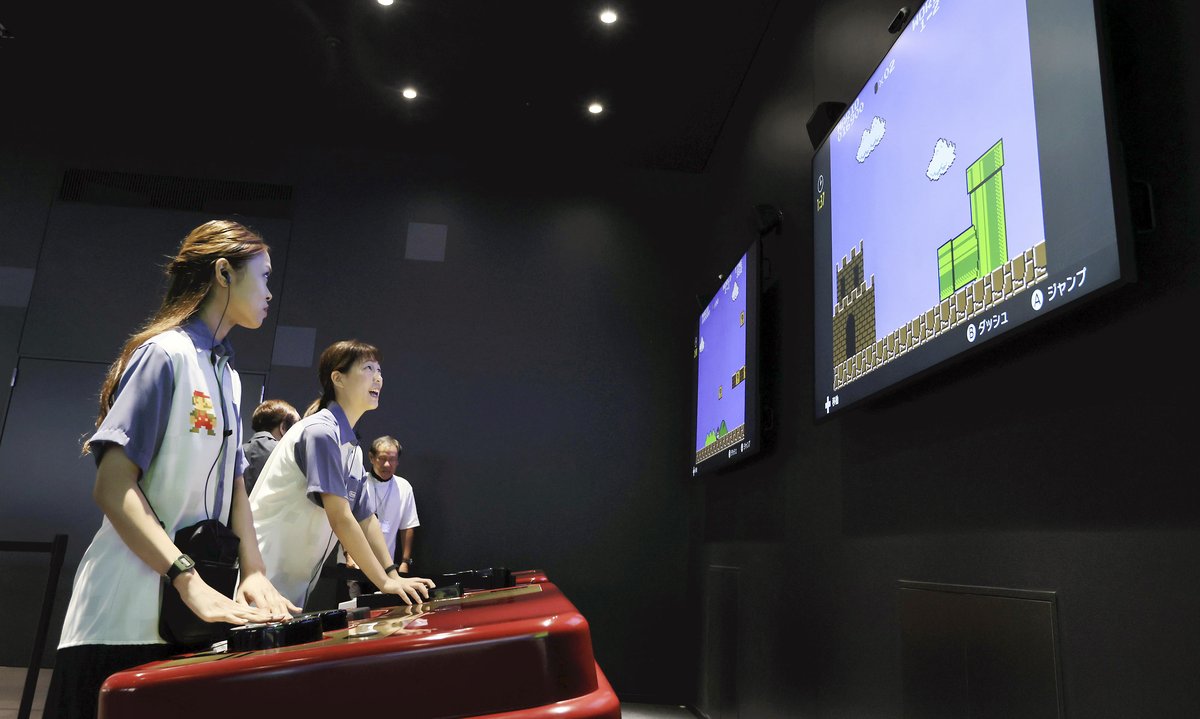Anticipation Rises For Nintendo’s Next Platform; Past Platforms Have Been Radically Innovative

The Nintendo Museum, where visitors can learn about Nintendo’s history in manufacturing and entertainment
8:00 JST, January 4, 2025
Nintendo, the brilliantly idiosyncratic giant of the video game platform world, will reach a significant milestone in 2025. The company is about to announce the successor to its flagship game console, the Nintendo Switch, which has sold more than 146 million units worldwide. Nintendo has consistently followed a unique strategy of regularly releasing new platforms, creating products that are easy to understand and play for the average user, and avoiding competition based on price or performance.
Take, for example, the Wii, released in 2006. This previously unknown type of game console, played by swinging a remote control with one’s whole arm instead of just using one’s fingers to press buttons as on a standard controller, is intuitive and fun for everyone to play. It tapped into previously unseen demand, including among women and the elderly. This development was also a brilliant anticipation of the shift to an era in which “content for family gatherings and enjoyment” would be in high demand, as the advent of large-screen, flat-panel TVs gave televisions — hardware devices that had come to be taken for granted as “one for each person” — renewed prominence in the living room.
Ten years later, the Switch was released and quickly transformed the market during the smartphone era by introducing a new way to play games. This portable console could be held in one’s hand or connected to a TV, offering flexibility and convenience.
This strategy was a clear departure from the approaches of rivals such as the Sony Group and Microsoft, which had moved toward higher functionality and more features. It was an expression of Nintendo’s commitment to the concept that “the true essence of a game is not high performance or high image quality; it is just fun.” In other words, the essence of Nintendo’s management is that “on a console with originality, talented creators have made excellent games that can only be played on that console.” Because of this originality, even if there were times when Nintendo’s business performance sank dramatically, it has repeatedly come back in a spectacular V-shaped recovery.
If this pattern holds, the successor to the popular Switch, which boasts the most prolonged lifespan of any console in history, should have an impact equal to or greater than the current model. However, based on current rumors and Nintendo’s official use of the term “successor,” the only thing that comes to mind is a vague image of an upgraded version of the Switch. Will Nintendo be able to spark fresh excitement in its fans again?
In an interview before the opening of the Nintendo Museum in October 2024, Shigeru Miyamoto, the executive fellow and representative director who is better known as the creator of the popular Mario character, said: “Kyoto has repeatedly experienced the rise and fall of the past. If we never become conceited, never dance around trends, and create what we feel and believe in, we will be supported around the world.”
The global video game content market, which Nintendo did much to shape, reached nearly ¥30 trillion in 2023. By region, East Asia, led by Japan, China and South Korea, accounted for 40% of the market and led its expansion. Does Nintendo perceive a new blue ocean that we cannot yet see? Anticipation for the announcement is increasing.
Political Pulse appears every Saturday.

Shingo Sugime
Shingo Sugime is a deputy editor in the Economic News Department of The Yomiuri Shimbun Osaka.
"Editorial & Columns" POPULAR ARTICLE
-

Violations of Subcontract Law: Major Automakers Must Eliminate Old Practices
-

Local Governments’ Tax Revenues: Devise Ways to Correct Imbalances in Tax Sources
-

5 Japanese Business Dinner Mistakes to Avoid — and What They Taught Me About Business in Japan
-

Heavy Rains in Asia: Support for Victims, Flood-Control Measures Urgently Needed
-

Rice Coupons: A Misguided Approach to Countering Rising Prices
JN ACCESS RANKING
-

Tokyo Economic Security Forum to Hold Inaugural Meeting Amid Tense Global Environment
-

Keidanren Chairman Yoshinobu Tsutsui Visits Kashiwazaki-Kariwa Nuclear Power Plant; Inspects New Emergency Safety System
-

Imports of Rare Earths from China Facing Delays, May Be Caused by Deterioration of Japan-China Relations
-

University of Tokyo Professor Discusses Japanese Economic Security in Interview Ahead of Forum
-

Japan Pulls out of Vietnam Nuclear Project, Complicating Hanoi’s Power Plans























